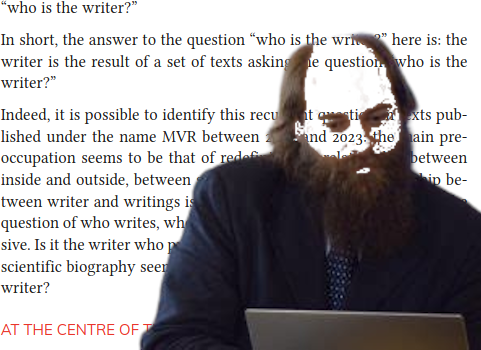Who is the Writer?
DOI:
https://doi.org/10.17742/IMAGE29705References
Alessi, Robert, and Marcello Vitali-Rosati, editors. Éditions critiques numériques : entre tradition et changement de paradigme. Presses de l’Université de Montréal, 2023.
Arrêté du 23 novembre 1988 relatif à l’habilitation à diriger des recherches. https://www.legifrance.gouv.fr/loda/id/JORFTEXT000000298904. Accessed 9 Jan. 2024.
Barad, Karen. Meeting the Universe Halfway: Quantum Physics and the Entanglement of Matter and Meaning. Second Printing edition, Duke University Press Books, 2007.
Barthes, Roland. Le Bruissement de la langue. Seuil, 1993.
Bayard, Pierre. Le Plagiat par anticipation. Les Éditions de Minuit, 2009.
Bergson, Henri. Essai sur les données immédiates de la conscience. P.U.F., 1948.
Bergson, Henri. L’évolution créatrice. Presses universitaires de France, 1966.
Deleuze, Gilles. Différence et répétition. Presses universitaires de France, 1972.
Derrida, Jacques. “Violence et métaphysique: Essai sur la pensée d’Emmanuel Levinas.” Revue de métaphysique et de morale, vol. 69, no. 3, 1964, pp. 322-54.
Eberle-Sinatra, Michael, and Marcello Vitali-Rosati. Pratiques de l’édition numérique. Presses de l’Université de Montréal, 2014, http://parcoursnumeriques-pum.ca/pratiques.
Epron, Benoît, and Marcello Vitali-Rosati. L’édition à l’ère numérique. La Découverte, 2018, https://papyrus.bib.umontreal.ca/xmlui/handle/1866/20642.
Foucault, Michel. “Qu’est-ce qu’un auteur ?” Dits et Écrits, Gallimard, 1994.
Habilitation à diriger des recherches. Jan. 2024, https://fr.wikipedia.org/w/index.php?title=Habilitation_%C3%A0_diriger_des_recherches&oldid=211342477.
Kittler, Friedrich A. Discourse Networks 1800/1900. Stanford UP, 1990.
Kittler, Friedrich A. “There Is No Software.” CTheory, Oct. 1995, https://monoskop.org/images/f/f9/Kittler_Friedrich_1992_1997_There_Is_No_Software.pdf.
Lévinas, Emmanuel. “En ce moment même dans cet ouvrage me voici.” Textes pour Emmanuel Lévinas, edited by François Laruelle, J.-M. Place, 1980, http://catalogue.bnf.fr/ark:/12148/cb34658416d.
Levinas, Emmanuel. Totalité et Infini : Essai sur l’extériorité. Le Livre de Poche, 1990.
Levinas, Emmanuel, and Jacques Rolland. De l’évasion. Fata Morgana, 1982.
Méchoulan, Éric, and Marcello Vitali-Rosati. L’espace numérique. Les atelier de Sens public, 2018, http://ateliers.sens-public.org/l-espace-numerique.
Merleau-Ponty, Maurice. Le visible et l’invisible : suivi de notes de travail. Edited by Claude Lefort, Gallimard, 1964.
Merleau-Ponty, Maurice. Phénoménologie de la perception. Gallimard, 1945.
Merzeau, Louise. “Le profil : une rhétorique dispositive.” Itinéraires. Littérature, textes, cultures, no. 2015–3, June 2016, https://doi.org/10.4000/itineraires.3056.
Ricœur, Paul. Autrement. Lecture d’« Autrement qu’être ou Au-delà de l’essence » d’Emmanuel Levinas. Presses universitaires de France, 1997, https://www.cairn.info/autrement--9782130489184.htm.
Treleani, Matteo. “Du spectre à l’automate. Deux figures du spectateur.” D’un écran à l’autre. Les mutations du spectateur, Delavaud, G. Chateauvert, J., Harmattan, 2016.
Vitali-Rosati, Marcello. “Auteur ou acteur du web.” Implications Philosophiques, 2012, http://www.implications-philosophiques.org/actualite/une/auteur-ou-acteur-du-web/.
Vitali-Rosati, Marcello. “The Chiasm as a Virtual - A Non-Concept in Merleau-Ponty’s Work (with a Coda on Theatre).” Merleau-Ponty and the Art of Perception, edited by Duane Davis and William S. Hamrick, North Carolina UP, 2016, pp. 279-296, http://www.sunypress.edu/p-6176-merleau-ponty-and-the-art-of-pe.aspx.
Vitali-Rosati, Marcello. Corps et virtuel : Itinéraires à partir de Merleau-Ponty. Harmattan, 2009.
Vitali-Rosati, Marcello. “Digital Architectures: The Web, Editorialization and Metaontology.” Azimuth. Philosophical Coordinates in Modern and Contemporary Age, vol. 4, no. 7, 2016, pp. 95-111.
Vitali-Rosati, Marcello. Égarements. Amour, mort et identités numériques. Hermann, 2014, http://vitalirosati.com/liseuse/spip.php?rubrique3.
Vitali-Rosati, Marcello. “La profondeur du théâtre : au-delà du sujet, vers une pensée métaontologique.” Sens-Public, June 2011, http://sens-public.org/spip.php?article846.
Vitali-Rosati, Marcello. “Le fait numérique comme « conjonctures médiatrices ».” Communication & Langages, no. 208–209, 2021, pp. 155-70.
Vitali-Rosati, Marcello. “Mais où est passé le réel ? Profils, représentations et métaontologie.” MuseMedusa, no. 6, 2018, http://musemedusa.com/dossier_6/vitali-rosati/.
Vitali-Rosati, Marcello. On Editorialization: Structuring Space and Authority in the Digital Age. 26, Institute of Network Cultures, 2018, https://papyrus.bib.umontreal.ca/xmlui/handle/1866/19868.
Vitali-Rosati, Marcello. “Pornspace.” Medium, no. 46–47, 2016, pp. 307-17.
Vitali-Rosati, Marcello. “Pour une pensée préhumaine.” Sens public, 2021, https://sens-public.org/articles/1598/.
Vitali-Rosati, Marcello. “Pour une théorie de l’éditorialisation.” Humanités numériques, vol. 1, 2020, http://journals.openedition.org/revuehn/371.
Vitali-Rosati, Marcello. “Qu’est-ce que l’écriture numérique ?” CORELA, vol. HS-33, Oct. 2020, https://doi.org/10.4000/corela.11759.
Vitali-Rosati, Marcello. Riflessione e trascendenza: itinerari a partire da Levinas. 63, ETS, 2003, http://www.edizioniets.com/Recensioni.asp?N=88-467-0677-3.
Vitali-Rosati, Marcello. S’orienter dans le virtuel. Hermann, 2012.
Vitali-Rosati, Marcello. “The Writer is the Architect.” Sens public, no. 1282, Dec. 2017, http://sens-public.org/articles/1288/.
Vitali-Rosati, Marcello. “What Is Editorialization ?” Sens Public, Jan. 2016, http://sens-public.org/article1059.html.
Vitali-Rosati, Marcello, and Jean-Marc Larrue. Media Do Not Exist. Institute of Network Cultures, 2019, https://papyrus.bib.umontreal.ca/xmlui/handle/1866/22937.
Vučković, Marko. “If One Has the Floor, Does One Also Need to Dance? Topology, Choreology, and the Structure of Digital Space.” Imaginations: Journal of Cross-Cultural Image Studies | Revue d’études interculturelles de l’image, Elicitations 1 July 2024.

Published
Versions
- 2025-06-18 (2)
- 2024-07-03 (1)
How to Cite
Issue
Section
License
Copyright (c) 2022 Marcello Vitali-Rosati

This work is licensed under a Creative Commons Attribution-NonCommercial-NoDerivatives 4.0 International License.

This work by https://journals.library.ualberta.ca/imaginations is licensed under a Creative Commons 4.0 International License although certain works referenced herein may be separately licensed, or the author has exercised their right to fair dealing under the Canadian Copyright Act.



